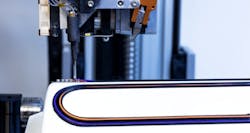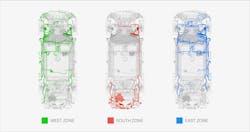Wire harnesses are the backbone of industries like automotive, aerospace and consumer electronics. They bundle multiple wires and cables into a package, ensuring organized and efficient electrical connections. Traditionally, assembling these harnesses has been a manual, labor-intensive and error-prone process. Yet, despite various attempts to automate this process, the results have neither achieved fully automated wire harness manufacturing nor effectively managed wire routing.
That’s not to say that wire harness automation hasn’t made significant strides in tasks like cutting, stripping, crimping and routing. In these applications, sophisticated and often costly machines can be used to achieve a high degree of automation to boost the efficiency and precision of repetitive tasks such as wire preparation, attaching terminals and routing wires into the correct position. Automated soldering and testing systems have also improved consistency and quality.
However, these systems are essentially automated versions of manual processes, which limits their effectiveness. The inherent complexity of wire harness designs — different wire lengths, connector types and routing configurations — has always required manual intervention, as current robotic systems aren’t able to fully adapt to these intricacies.
Automated wire harness manufacturing
To tackle these challenges, a fully automated wire harness manufacturing technology has been developed using cartesian robotics and additive manufacturing to integrate bare or insulated wires directly onto or within product components. Known as Electrical Function Integration, this method employs proprietary CAD/CAM robotic manufacturing cells developed by Q5D.
The self-contained units are designed for autonomous operation and require only power and internet connectivity to move and position tools with high precision in three-dimensional space — an essential requirement for accurately placing wires and conductive tracks in complex geometries.
Built on a tubular steel frame with impact-resistant polymer cladding, the cells feature a five-axis motion control system comprising three linear axes and two rotational axes. The system employs high-speed linear motors for the X and Y axes (up to 1 m/s) and Z axis (up to 0.5 m/s) to maximize accuracy.
Hollow motors control the rotational axes (normal speed 70 rev/min, max 200 rev/min) to deliver precision movements of the linear axis within ±5 ?m, on the B-axis within ±30 arc sec and on the C-axis within ±10 arc sec. The system achieves better than ±50 microns accuracy at any point within the build volume and throughout the programmed path of movement.
To deliver this accuracy, the cell features a custom motion controller and post-processor along with Siemens NX CAD/CAM software to execute complex 3D movements for precise wire laying and polymer deposition.
The system supports the deposition of industry-standard wires, whether bare or insulated, directly from a drum, as well as a range of glues — such as hot melt and epoxy — to secure wires in place. It can also work with a wide variety of polymers, from nylon to PEEK, enabling accurate and directional placement of materials in the planned tool path.
By integrating wiring directly into product structures, this method eliminates the need for additional materials, reducing overall product weight and improving efficiency. It also minimizes material waste and manual labor, leading to substantial cost savings and supporting on-demand production. This reduces the need for extensive inventories and associated storage costs while allowing for greater customization and adaptability in wire harness design without extensive retooling.
Wire and connector application considerations
Wires and connectors need to handle electrical loads, mechanical stress and operating conditions like high temperatures, moisture and chemicals. Depending on specific industry requirements, different types of wires — such as single-core for simple connections, multi-core for complex needs, coaxial for high-frequency signals, micro coaxial for limited space, or fiber optic for high bandwidth — are chosen based on the application’s requirements. The choice of routing configuration also impacts the overall performance of a wiring harness, affecting factors such as signal integrity, power distribution efficiency, electromagnetic interference and ease of maintenance.
Electrical Function Integration considers all these factors — evaluating conductivity, flexibility, adhesion properties and automatic termination capability. An advantage of this method is that it typically allows manufacturers to use their existing wires without any modifications, and largely the same connectors as well. The chosen wires must be compatible with additive manufacturing techniques and withstand the product's overall environmental conditions.
A crucial factor involves ensuring the choice of glue or polymer is compatible with the wire and the substrate or part onto which the wire is to be attached.
The 3D polymer process in Q5D’s Electrical Function Integration technology uses five-axis manufacturing to deposit polymers in complex 3D shapes. This capability enables the creation of wire traps, secures wires through overprinting, insulates connectors and bare wires and forms 3D features.
This helps minimize product weight by securely anchoring and supporting wires in a permanent position, allowing for the use of thinner or lighter wires tailored to the required conductivity. By contrast, in traditional wire harnesses the wire size is adversely influenced by the lack of control over mechanical stresses experienced during manufacturing, often necessitating larger wire sizes.
How wire harness automation is impacting industry
In the automotive industry, vehicles now need complex electrical systems for safety features, infotainment and engine control. Evaluation has shown that using five-axis robotic cell technology to integrate electrical wiring directly onto vehicle headliners can streamline the process, allowing a single robot cell to affix the wiring into 30,000 headliners annually.
Aerospace companies see benefits from reducing weight and improving reliability. Here, Electrical Function Integration can potentially reduce the weight of each business-class seat by about five kilograms. This weight reduction means planes can fly further and emit less carbon dioxide.
In the field of contactless communications, traditional NFC card reader manufacturing involves a five-step process. With Electrical Function Integration, a single bare wire is laid onto an injection-molded part with automated terminations. This approach can process up to 50 parts simultaneously, cutting manufacturing steps by 60% and reducing takt time from 120 seconds to 15 seconds — an 87% improvement. Plus, it eliminates the 30-day lead time from third-party suppliers by combining production and final assembly in one place.
Simon Baggott is chief marketing officer at Q5D Technologies.
More robotics coverage from Automation World:
Sponsored Recommendations
Leaders relevant to this article:




